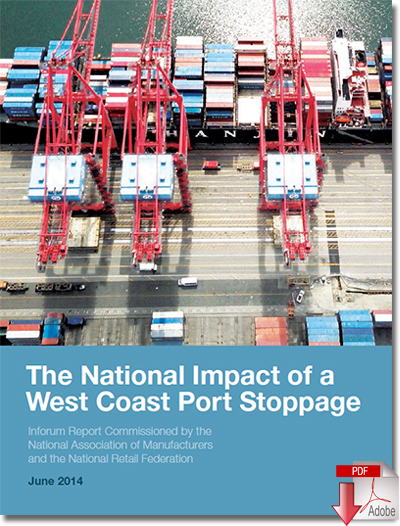West Coast Ports Labor Contract Still In the Making
With the deadline for labor contract negotiations between the International Longshore Warehouse Union and the Pacific Maritime Association arriving last night, the current status remains in flux.
As the calendar turns to July today, summer is fully intact, but the West Coast ports labor situation is still apparently chilly.
With the deadline for labor contract negotiations between the International Longshore Warehouse Union (ILWU) and the Pacific Maritime Association (PMA) arriving last night, the current status remains in flux as neither party is publicly commenting on their talks, which have been ongoing since May 12.
The ILWU represents nearly 14,000 port workers in California, Oregon, and Washington, with more than 40 percent of U.S. incoming container traffic moving through West Coast ports at the Ports of Los Angeles and Long Beach, according to industry estimates. The PMA represents shipping lines and terminal operators at 29 West Coast ports.
As previously reported, the ILWU’s president Bob McEllrath has told members to “hold the line,” and encouraged them to propose strategies to address the challenges ahead, including: -jurisdiction – efforts by the employers and other unions to “poach” Longshore jobs; -health Care & Pensions – increased employer & government pressure to cut benefits; and -automation employer efforts to replace workers with new technology.
As for the PMA’s stance, a report in the International Business Times cited the PMA as pointing to lost market share and the need to increase efficiency to maintain a competitive advantage against ports in Canada, Mexico, and the U.S.-based East and Gulf Coast ports.
And the report added that the PMA claims that annual earnings for full-time longshoremen average $132,046 along with generous no-deductible health benefits, while the ILWU says that the current labor contract calls for $35 per hour for the most experienced workers, or an annual salary of $72,800 per year. And according to the PMA 2013 annual report, 34 percent of longshore workers get less than 1,600 hours of work per year or roughly 30 hours a week.
One big action item at of near the top of many shippers’ to do lists since before negotiations commenced is having a contingency plan of some sort in place, given the fact that West Coast ports are such an important part of the global economy as a gateway to Asia for import and export activity.
National Retail Federation Vice President of Supply Chain and Customs Policy Jonathan Gold said last month that if talks go only a couple days past the expiration of the contract, then shippers should be fine, but it could be a different story if things go longer as far as being able to get product to market, while for exporters, it could shut down assembly line production as many companies run operations on a just-in-time basis.
And for importers getting into the peak shipping season for back to school and the holiday season, our members want to make sure they have the inventory they expect to have so consumers can get them at their stores.
As for contingency plans if negotiations go longer than expected, Gold said one option for importers is to ship early so there is sufficient inventory on hand, although it comes with additional costs to carry inventory longer than usual. Another option is shifting cargo to East and Gulf coast ports as well as Canada and Mexico, with air cargo as option for last minute orders, which is far more expensive.
“The National Retail Federation urges the International Longshore and Warehouse Union and Pacific Maritime Association to remain at the negotiating table until a new contract agreement is reached,” Gold said today in a statement provided to Logistics Management by the NRF. “Both parties need to understand the consequences of a potential port disruption and its adverse impact on consumers, stakeholders and the broader U.S. economy. Global supply chain stakeholders be it farmers, manufacturers, importers, retailers or transportation service providers need certainty and predictability, and are counting on the West Coast ports for imports and exports A new port contract will only be achieved if the ILWU and PMA remain at the table and work through any outstanding issues or disputes without engaging in a slowdown or stoppage.”
An industry source with knowledge of the tight-lipped negotiations told Logistics Management that there is speculation that the ILWU and PMA will keep bargaining past the deadline without any actual work stoppage this summer.
“Expectations are that there will be occasional slow downs and spotty muscle flexing by the ILWU local membership but the bottom line seemed to come down expecting 4-to-10 weeks more of hard bargaining which will result in a contract without a coastwise work stoppage,” the source said. “More speculation was how long the new contract would be for and what issues would really be addressed as opposed to being deferred to a future contract negotiation for resolution, perhaps as soon as in three years as opposed to the traditional six years.”
The need for the sides to come to an agreement is urgent in the sense that last time they failed to do so in 2002, there was a ten-day work stoppage at West Coast ports which caused an estimated $15 billion in reported losses and created a backlog that took several months to be cleared and cost the U.S. economy an estimated $15 billion in reported losses.
The Associated Press reported that one area where the Pacific Maritime Association is looking for concessions is benefits, citing the PMA as saying the cost of benefits more than doubled over the past decade, reaching $93,200 per registered worker in fiscal year 2013. What’s more, during these negotiations, a new incentive coming in the form of a 40 percent tax on the value of “Cadillac” health plans above a certain threshold kicks in under the Affordable Care Act, which the ILWU’s coverage qualifies, takes hold in 2018.
Related: Costs of Possible West Coast Port Strike are Significant, According to NAM and NRF Study















